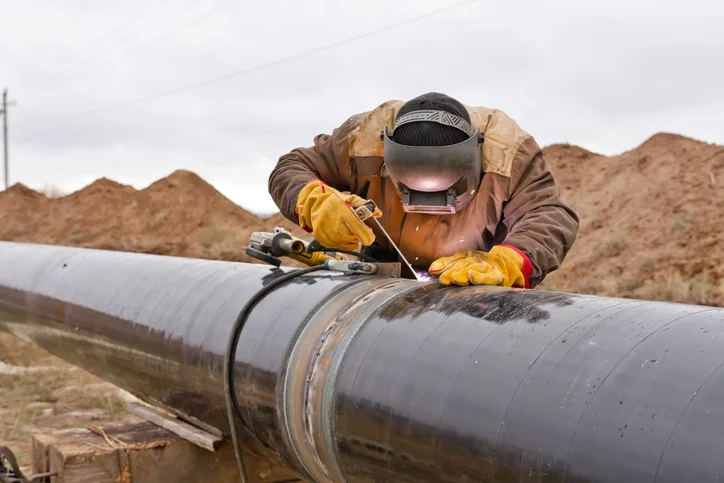Security First: Comprehensive Pipeline Welding Inspection for every single Task Stage
Security First: Comprehensive Pipeline Welding Inspection for every single Task Stage
Blog Article
Making The Most Of Efficiency: Pipe Welding Inspection Ideal Practices
By carrying out best practices for pipeline welding examination, organizations can enhance processes, minimize errors, and enhance project timelines. The meticulous focus to information needed in welding inspection holds the vital to the long-term toughness and dependability of the pipelines, making it a topic of utmost relevance in the market.

Importance of Reliable Welding Inspections
Effective welding examinations play a vital function in making sure the structural integrity and safety of pipes. Appropriate examinations are important to identify any type of defects, suspensions, or imperfections in the welded joints that could compromise the overall integrity of the pipe system. By conducting thorough assessments, examiners can detect issues early, avoiding potential leaks, ruptures, or failings that can have serious ecological and safety repercussions.
Exact and timely welding inspections additionally help in maintaining conformity with industry standards and guidelines. Following these standards is not only a legal need but additionally a needed step to assure the integrity and long life of the pipelines. Efficient assessments can add to set you back savings by reducing the demand for costly repair work or substitutes due to welding defects that can have been protected against or dealt with throughout the examination process.
Utilizing Innovation for Evaluations
To enhance the efficacy and accuracy of pipeline welding assessments, the integration of sophisticated innovations has come to be increasingly imperative in guaranteeing exact and thorough analyses of bonded joints. One of the essential technological developments in pipe welding assessments is the usage of automated ultrasonic screening (AUT) systems. By welcoming these technical remedies, pipe welding inspections can be performed a lot more successfully, leading to higher high quality welds, boosted overall security, and decreased task timelines.
Developing Clear Inspection Procedures
Developing clear inspection methods is vital for making sure consistency and dependability in the pipe welding examination procedure. These procedures act as a collection of standards that describe the details steps, standards, and methods to be followed during assessments. By plainly defining the inspection protocols, all assessors entailed in the process can understand their duties and obligations, leading to an extra standard and efficient assessment workflow.

Regular review and updates to the assessment protocols are likewise crucial to adjust to changing sector requirements and requirements. By constantly refining and enhancing the protocols based on comments and lessons discovered, pipe welding assessments can maintain the finest criteria and governing compliance.
Training and Qualifications for Inspectors

Training and qualifications for inspectors are extremely important in making sure the proficiency and effectiveness of people charged with managing pipeline welding processes - Pipeline Welding Inspection. Effectively educated inspectors possess the necessary expertise and skills to properly assess weld high quality, adherence to welding treatments, and compliance with market requirements and laws
Qualifications, such as those offered by the American Welding Culture (AWS) or the American Petroleum Institute (API), confirm an examiner's experience and capacity to execute inspections to the highest possible standards. These certifications often require strenuous training, evaluations, and recurring specialist development to ensure that inspectors stay present with the most up to date developments in welding innovation and examination techniques.
In addition to formal qualifications, constant training programs play a vital duty in improving examiners' abilities. These programs cover a vast array of subjects, consisting of welding processes, issue this article discovery, security protocols, and appropriate codes and criteria (Pipeline Welding Inspection). By investing in thorough training and accreditations for assessors, business can promote the honesty of their pipeline welding tasks and reduce the dangers related to second-rate welds
Continuous Enhancement in Assessment Procedures
Building upon the structure of experienced and certified inspectors, constant renovation in evaluation procedures is vital for ensuring the recurring high quality and find more info compliance of pipe welding procedures. By implementing a system of constant renovation, pipe welding inspection processes can evolve to satisfy the transforming demands of the sector, technical improvements, and regulatory needs. This involves regularly examining and examining evaluation methods, tools, and treatments to identify areas for enhancement.
One key element of constant renovation in assessment procedures is responses. Gathering input from inspectors, welders, engineers, and various other stakeholders enables for an extensive evaluation of current techniques and the identification of potential locations for enhancement. Furthermore, leveraging data and analytics can provide useful insights right into the performance of examination processes, allowing educated decision-making for optimization.
Furthermore, buying training and advancement programs for inspectors can ensure that they are outfitted with the most recent expertise and skills to do their responsibilities effectively. Continual enhancement is a vibrant process that needs commitment and dedication from all stakeholders to drive excellence in pipeline welding inspection methods.
Conclusion
Finally, making the most of efficiency in pipe welding evaluations is important for making sure the top quality and safety of framework tasks. By making use of technology, establishing clear procedures, offering proper training and certifications for inspectors, and continually boosting examination procedures, organizations can improve their operations and minimize dangers. It is necessary for industries to prioritize reliable welding inspections to maintain high requirements and meet regulatory requirements.
Efficient assessments can add to cost savings by lessening the requirement for costly fixings or replacements due to welding problems that can have been protected against or remedied during the inspection procedure.
Establishing clear Check This Out assessment procedures is important for making certain consistency and reliability in the pipeline welding evaluation process. By plainly specifying the examination methods, all assessors included in the process can understand their duties and functions, leading to an extra standardized and effective inspection process.
Clear inspection methods help in reducing the chance of errors or oversights throughout the evaluation process.Building upon the foundation of qualified and qualified assessors, constant renovation in examination processes is necessary for guaranteeing the continuous quality and conformity of pipe welding operations.
Report this page